Newcastle Horse Tramways
(Newcastle Tramway Company, subsequently the Newcastle and Gosforth Tramway and Carriage Company)
History
Newcastle Corporation's standard gauge horse tramway opened for business on the 5th December 1878; the corporation however did not operate the tramway itself — this was prohibited by the Tramways Act of 1870 — so it was leased to William Turton and Daniel Busby. Turton and Busby were well-known tramway entrepreneurs, who either separately or together had interests in several horse tramways in the north of England, most notably, those of Manchester, Leeds, Liverpool and Salford.
Corporation extensions were opened in 1880, 1881 and 1883, the lease for all co-terminating with the original lease, which ran for 21 years to the 11th November 1899. The company also built its own line from the Newcastle municipal boundary on the Great North Rd to Gosforth, which it opened in 1881. At its maximum, the horse tramway system extended to 12.19 miles with lines from the city centre radiating: southwestwards along the Scotswood Rd to the Benwell boundary at Scotswood Toll; westwards along Westgate Rd to its junction with the northern end of Bentinck Rd, with a branch leading off southwestwards along Elswick Rd to its junction with the southern end of Bentinck Rd; northwards along the Great North Rd and over the boundary with Gosforth to Coxlodge; northeastwards from the Great North Rd along Jesmond Rd to Jesmond Toll Bar, with a branch leading off northwards along Osbourne Rd to its junction with Mistletoe Rd; and finally, eastwards along New Bridge St and Shields Rd to Byker.
The initial lines suffered from a poor choice of rail, which was also poorly laid; this, together with mining subsidence (on some routes) led to a rapid deterioration of the track, the initial tranche of lines having to be relaid at significant expense.
In early 1880, Turton and Busby introduced steam trams on the Great North Rd — on a trial basis — but this move ran into vociferous opposition from the local carriage-owning classes, the last steam service probably running in the spring of 1881. The company also ventured into omnibus operation (in 1885), often introducing them on routes which the corporation aimed to have as tramway extensions, but which the company stated it would not lease (if built).
Around January 1885, it was reported to the corporation that Turton and Busby had set up a new company — the Newcastle Tramway Company — to work the tramway. Whilst letterheads, buttons and horse brasses all bore the title of the new company, there is considerable doubt as to whether it ever formally existed (legally), and there is every possibility that it was simply an unofficial construct of Turton and Busby. Busby died on the 3rd April 1887, and his share of the 'company' passed to his heirs. Given that the leases were all with Turton and Busby, the situation was regularised on the 4th September 1889, when they were all transferred to a new company — the Newcastle and Gosforth Tramway and Carriage Company — of which Turton was a director.
In 1892, the corporation started a long and ultimately fruitless dalliance with the idea of converting some or all its lines to cable traction, something the company was not interested in, making its views known to the corporation in mid-1893. A change of ownership however — in November/December 1893 — brought a fresh approach and a willingness to consider cable traction. Electric traction was however also coming to the fore, and whilst the corporation took a long, hard look at its options, key voices were set against the perceived disfigurement of overhead electric wires, and on 9th November 1895, the full council voted to promote a cable system. There followed however, a further and protracted period of discussion, including not just the question of traction — cable, conduit and overhead all being in contention — but whether the corporation wished to lease whatever new system it built, or whether it would operate it itself. On the 25th January 1898, the council finally decided to obtain powers to run the tramway itself following the end of the company's lease (11th November 1899), and these were duly acquired during 1899.
Relations between the tramway company and the corporation were however not exactly cordial, given that the former had been hoping to lease the new tramway, and had to some extent been strung out by the council's inability to make up its mind. Nevertheless, on the 7th November 1899, agreement was reached for the company to continue working the horse tramway until the corporation was ready to convert the existing lines to overhead electric traction (a decision having finally been made on the form of traction to be used) initially until the 1st December 1899, and thereafter, subject to three months' notice.
Construction of the new system commenced on the 19th April 1900, and on the 10th January 1901, the council gave notice to the company that the lease of the existing lines would be terminated on the 13th April 1901. The corporation seemingly wanted the company to continue working the lines during conversion, but the company was not interested in the terms offered, so all services stopped that day, leaving omnibuses to fill the transport gap for the best part of 8 months.
Uniforms
Unfortunately, photographs of Newcastle Horse Tramways staff are rare, and what has survived is very difficult to date with anything approaching accuracy. There are in fact no photographs which can be securely dated to the days of Turton and Busby (1878 to 1885) or the Newcastle Tramway Company (1885-1888), so it is impossible to say what horsecar crews wore during the first ten or so years of the system's life. Several examples of heavily worn buttons from the Newcastle Tramway Company have however survived (see link), which does suggest that uniforms were issued at some point during these early years.
The photographic record is better for the late 1880s onwards, i.e., under the auspices of the Newcastle and Gosforth Tramway and Carriage Company (1888 to 1901), but is still tricky to date accurately, and close-ups of staff are almost unknown. The earliest photos — probably taken in the late 1880s or early 1890s — clearly show that informal attire was worn, namely: shirt, jacket and tie, along with the fashionable headgear of the day, invariably the bowler hat. At some point, possibly in the early-to-mid 1890s, uniforms were introduced, though precisely what form they took, or whether they bore insignia, is impossible to say. Both conductors and drivers did however wear tall kepi-style caps with glossy peaks, often referred to as 'pill boxes'; they seem not to have carried a cap badge, at least not a metal one that would show up (through reflection) on photographs.
Photographs of inspectors have not survived, so it is currently impossible to say what uniforms were worn, or indeed, if the owning companies ever employed them.
Further reading
For a history of Newcastle's horse trams, see: 'Newcastle-upon-Tyne Horse Trams' by J Yarham, in the Tramway Review No 198 (p208-226); Light Railway Transport League (2004).
Images
Horse tram drivers and conductors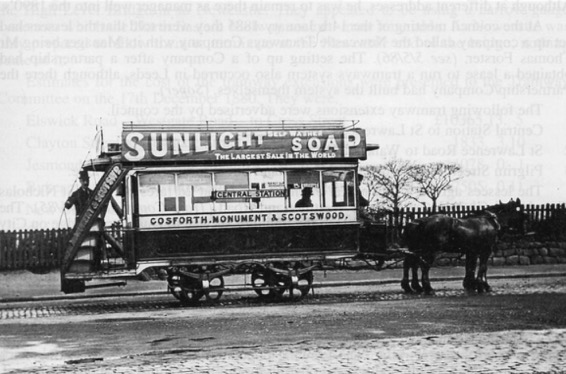
A Newcastle horse car captured on what is believed to be the Gosforth line over Town Moor — the photo is unfortunately undated, but the conductor's tall bowler suggests that it was taken in the late 1880s or early 1890s. The conductor is wearing informal attire, though the situation with the driver is less clear, and it is possible that he is wearing a kepi-style cap. Photo courtesy of the Tramways and Light Railway Society, with thanks to David Voice.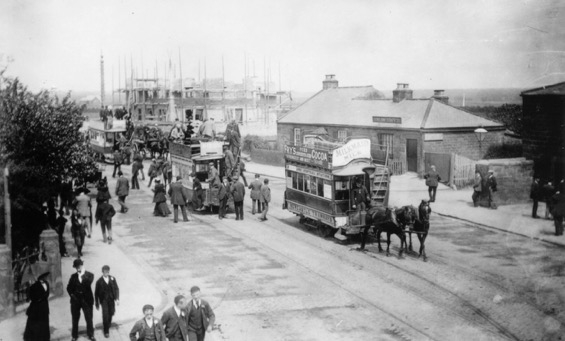
Three horsecars captured at the Gosforth terminus on what was undoubtedly race day — photo undated, but from the fashions on display, probably taken in the early 1890s. Photo courtesy of the Tramways and Light Railway Society, with thanks to David Voice.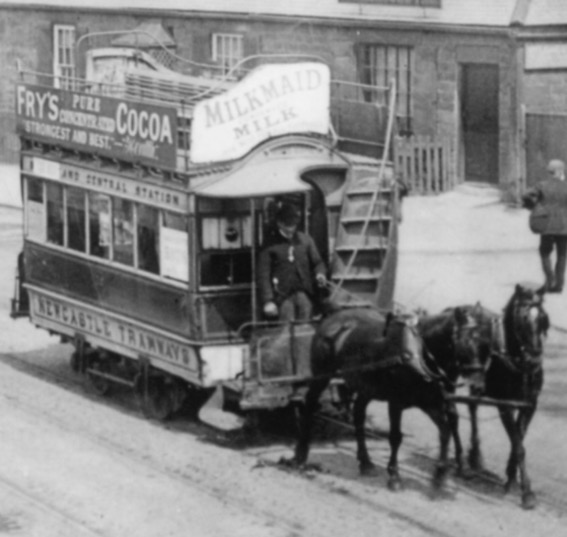
A blow-up of the above photo showing the driver of the first horsecar; he is wearing informal attire along with a bowler hat.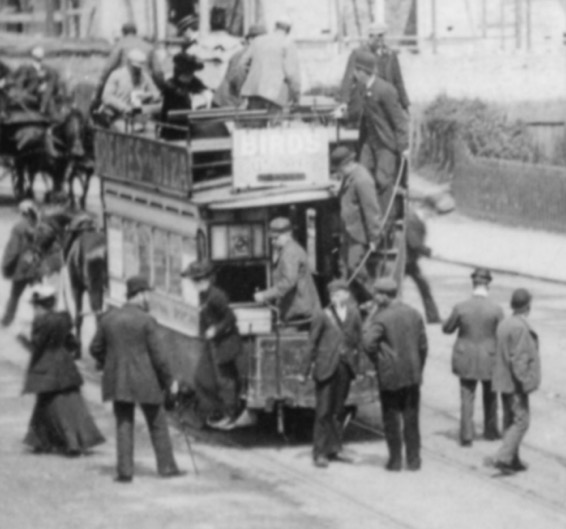
Another blow-up of the above photo, this time showing the conductor of the second horsecar (in the centre with a cash-bag strap); he is also wearing informal attire, but with a flat cap.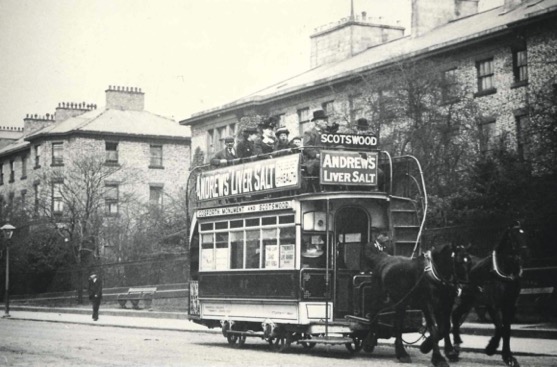
An unidentified horsecar bound for Scotswood on the Great North Rd — photo believed to have been taken in 1894. Photo courtesy of the West Newcastle Picture History Collection.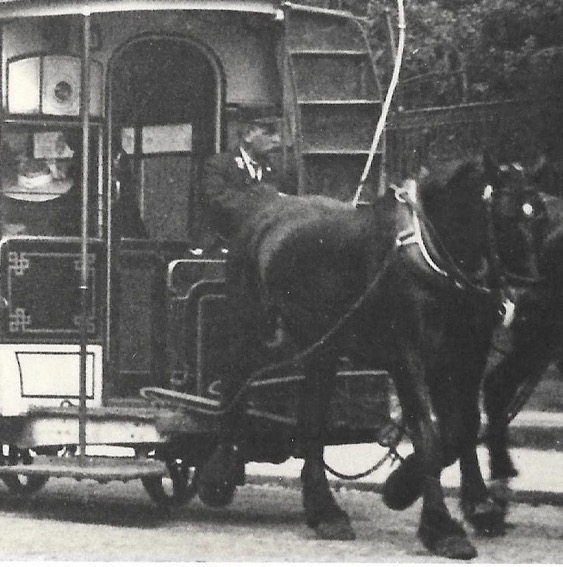
A blow-up of the above photo showing the driver. He is clearly wearing a uniform jacket, which may bear a collar badge, along with a kepi-style cap.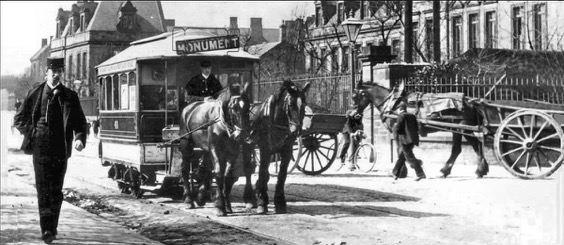
Newcastle & Gosforth Tramways and Carriage Company Horse Car No 43 outside the council offices in Gosforth High St with a service for Grey's Monument — photo undated, but probably taken around 1900. Image kindly supplied by Malcolm Fraser.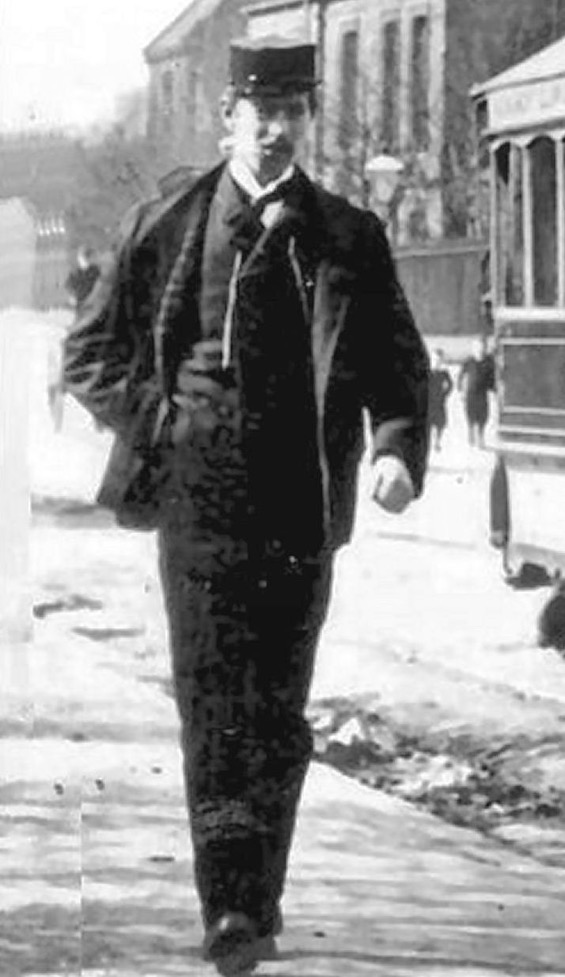
A blow-up of the above photo showing the figure on the left, who would appear to be a tramway company employee. He is wearing a double-breasted uniform jacket with lapels, along with a kepi-style cap; the latter does not appear to bear a cap badge, at least a metal one that would reflect the light.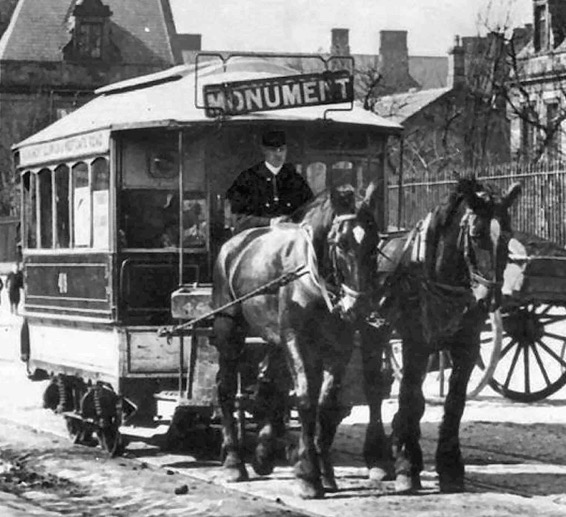
Another blow-up of the above photo, this time showing the driver. He is wearing a double-breasted greatcoat along with a kepi-style cap; once again the latter does not appear to bear a badge, though this is difficult to say with certainty.